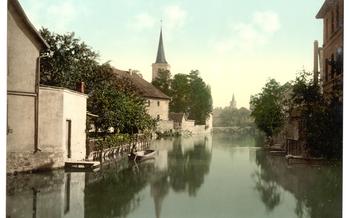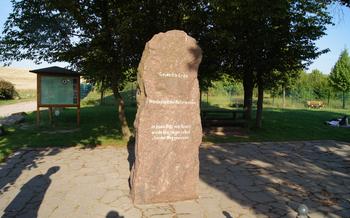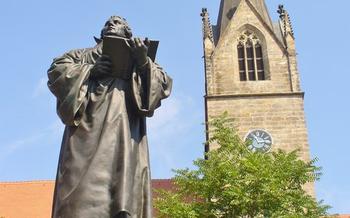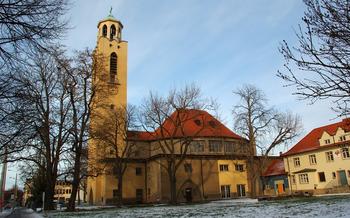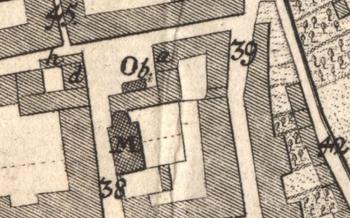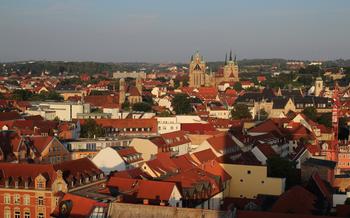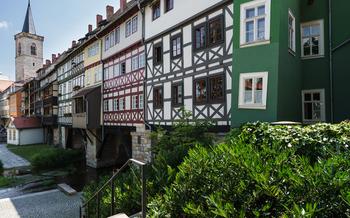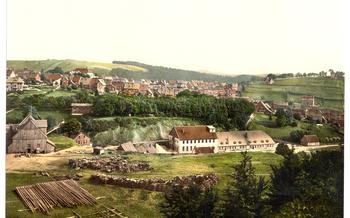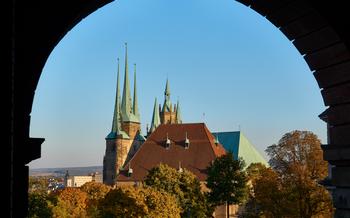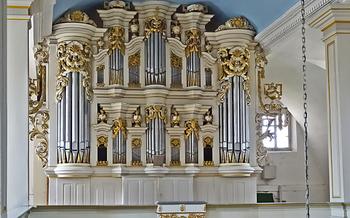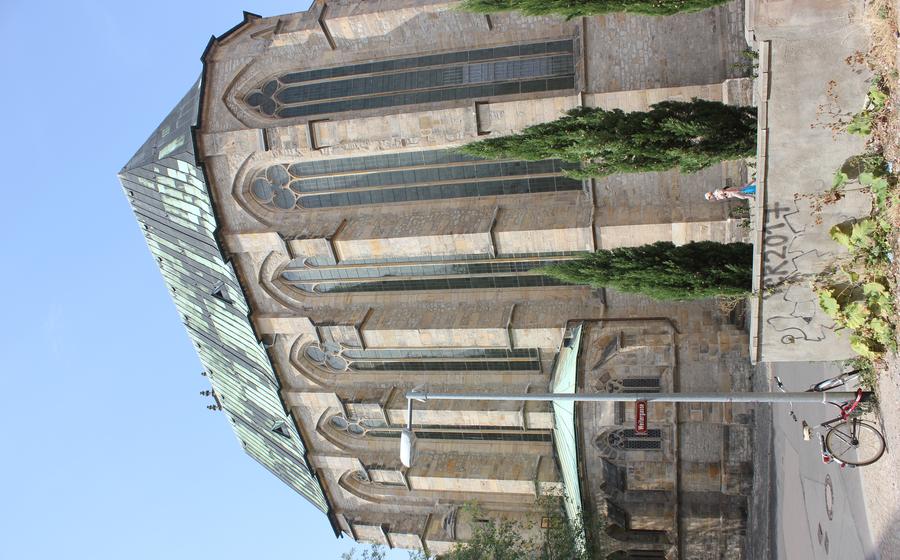
Barfüßerkirche Ruins
- Barfüßerkirche Ruins: A Symbol of Erfurt's History
- Location and Accessibility
- History of the Barfüßerkirche
- Architectural Highlights
- Significance During the Reformation
- Destruction and Rebuilding
- Unique Features
- Visiting the Barfüßerkirche Ruins
- Things to See and Do Nearby
- Shopping and Dining Options
- Photography Opportunities
- Local Legends and Folklore
- Insider Tip
Barfüßerkirche Ruins: A Symbol of Erfurt's History
In the heart of Erfurt, a city steeped in history and culture, stands a poignant reminder of a bygone era: the Barfüßerkirche Ruins. Once a magnificent Franciscan church, the Barfüßerkirche now stands as a testament to the city's tumultuous past. Its Gothic arches, worn and weathered by time, speak volumes about Erfurt's rich heritage and the profound impact of the Reformation on the city's religious and cultural landscape.
The Barfüßerkirche, meaning "Barefoot Church," was constructed in the 13th century by the Franciscan order, a mendicant order known for their vow of poverty and their commitment to living a simple life. The church quickly became a spiritual and intellectual hub, attracting pilgrims and scholars from far and wide. Its architectural grandeur, featuring intricate stone carvings and soaring vaulted ceilings, reflected the order's devotion and their desire to create a sacred space worthy of divine worship.
Throughout its existence, the Barfüßerkirche played a pivotal role in shaping Erfurt's religious and cultural identity. It served as a venue for religious debates, theological discussions, and the dissemination of knowledge. The church's association with Martin Luther, a key figure in the Protestant Reformation, further cemented its significance as a center of religious reform. However, the Reformation's impact also led to the church's eventual abandonment and subsequent decline.
Location and Accessibility
The Barfüßerkirche Ruins are strategically situated in the heart of Erfurt, Germany, at Barfüßerstraße 1This prime location places them within easy reach of other prominent landmarks and attractions, making it an ideal starting point for exploring the city's rich history and cultural heritage.
To reach the ruins, visitors can opt for various transportation modes. Public transportation enthusiasts can take advantage of the well-connected network, with several bus stops located nearby. For those who prefer the convenience of driving, ample parking facilities are available in the vicinity.
The Barfüßerkirche Ruins are dedicated to ensuring accessibility for all visitors, including those with disabilities. Wheelchair ramps, elevators, and accessible restrooms have been thoughtfully incorporated to accommodate the needs of every individual. Whether you arrive by foot, public transport, or personal vehicle, you will find that the ruins are easily accessible, welcoming you to immerse yourself in the captivating history of Erfurt.
History of the Barfüßerkirche
The Barfüßerkirche, meaning "Barefoot Church" in English, traces its origins back to the 13th century when a group of Franciscan friars, known for their vow of poverty and walking barefoot, settled in Erfurt. They constructed a modest chapel on the site in 1224, marking the foundation of the church. Over the following decades, the chapel underwent significant expansions and renovations, transforming into a grand Gothic structure.
In the 16th century, the Protestant Reformation swept through Germany, and Erfurt became a center of religious debate. Martin Luther himself visited the city in 1521, delivering sermons at the Barfüßerkirche and influencing the spread of Protestantism in the region. However, the church faced opposition from the Catholic authorities, and in 1525, it was forcibly closed and confiscated by the city council, marking the end of its religious function.
During World War II, the Barfüßerkirche suffered extensive damage in Allied air raids, reducing it to a skeletal ruin. Despite the devastation, the ruins remained a poignant symbol of Erfurt's past, and efforts were initiated to preserve and restore the site. Archaeological excavations revealed valuable insights into the church's history, uncovering medieval artifacts and shedding light on its architectural evolution.
Architectural Highlights
The Barfüßerkirche Ruins stand as a testament to the grandeur of Gothic architecture. Constructed in the 13th century, the church exhibits the characteristic pointed arches, ribbed vaults, and intricate tracery that define this architectural style. Although reduced to ruins, the remaining structures showcase the exceptional craftsmanship and artistry of medieval builders.
The ruins feature a series of elegant arches that once formed the nave and aisles of the church. These arches, adorned with intricate carvings, create a sense of rhythm and movement, drawing the eye upwards towards the vaulted ceilings. The vaults, though partially collapsed, still display remnants of their original ribbed structure, demonstrating the innovative engineering techniques employed by Gothic architects.
Despite the passage of time and the ravages of war, the Barfüßerkirche Ruins retain their distinctive charm and character. The remaining pillars, columns, and walls, though weathered and worn, evoke the grandeur and splendor of the original church. Visitors can admire the delicate tracery of the windows, the intricate carvings on the capitals, and the remnants of frescoes that once adorned the walls.
The Barfüßerkirche Ruins offer a unique opportunity to study and appreciate the architectural achievements of the Gothic period. Their enduring presence serves as a reminder of the artistic and spiritual heritage of Erfurt and its role in shaping the architectural landscape of Germany.
Significance During the Reformation
During the 16th century, the Barfüßerkirche played a pivotal role in the Protestant Reformation. Martin Luther, the leading figure of the Reformation, visited Erfurt in 1521 to debate with Catholic theologians. The church became a center of religious debate and reform, attracting followers of Luther's teachings. However, the church's support for the Reformation led to its closure by the Catholic authorities in 1525, marking a significant moment in the religious conflicts that swept through Germany. This closure symbolized the growing divide between the Catholic Church and the emerging Protestant movement, contributing to the complex religious landscape of the era.
Destruction and Rebuilding
During the relentless air raids of World War II, the Barfüßerkirche, like many other historic structures in Germany, suffered extensive damage. In 1944, a direct hit from a bomb caused the church's nave and chancel to collapse, leaving only the tower, the choir, and portions of the outer walls standing. The ruins became a poignant reminder of the devastation wrought by war.
In the aftermath of the war, the people of Erfurt were determined to preserve and restore their beloved landmark. In the 1950s, a comprehensive reconstruction project was initiated, guided by the principles of historical preservation. Skilled craftsmen and architects worked tirelessly to restore the remaining elements of the church, using traditional techniques and materials. The choir, with its intricate vaults and delicate tracery, was meticulously rebuilt, along with the tower, which had sustained significant damage.
The reconstruction process was not without its challenges. Sourcing authentic materials and replicating the original craftsmanship proved to be a formidable task. Additionally, the need to balance historical accuracy with structural stability required careful consideration. Nonetheless, the restoration efforts bore fruit, and in 1981, the Barfüßerkirche ruins were reopened to the public, serving as a testament to the city's resilience and its commitment to preserving its cultural heritage.
Unique Features
The Barfüßerkirche Ruins stand out not only for their historical significance but also for several unique features that add to their charm and allure. One notable aspect is the presence of a serene cloister garden nestled within the ruins. This tranquil oasis offers a peaceful retreat from the bustling city, allowing visitors to pause and reflect amidst the ancient stones.
Excavations at the site have yielded fascinating archaeological discoveries, including remnants of medieval pottery, coins, and other artifacts that provide glimpses into the daily lives of the friars who once resided here. These findings shed light on the church's past and the vibrant community that surrounded it.
The preserved bell tower of the Barfüßerkirche is a striking symbol of the church's resilience and endurance. Despite the ravages of time and war, the tower remains largely intact, its Gothic arches and intricate carvings still visible. It serves as a reminder of the church's former glory and stands as a beacon of hope and renewal.
The artistic and cultural value of the remaining structures at the Barfüßerkirche Ruins cannot be overstated. The intricate carvings, delicate tracery, and soaring arches are testaments to the skill and artistry of the medieval craftsmen who built the church. These architectural elements contribute to the site's unique character and provide a glimpse into the artistic heritage of Erfurt.
Visiting the Barfüßerkirche Ruins
The Barfüßerkirche Ruins are open to the public and offer a unique and awe-inspiring experience. Visitors can explore the ruins at their own pace or take advantage of the guided tours available. Audio guides are also available for a more immersive and informative visit. The ruins are accessible to visitors with disabilities, ensuring everyone can experience this historic site.
It is recommended to set aside at least an hour to fully explore the ruins and appreciate their significance. The best time to visit is during the warmer months when the weather is pleasant, and the ruins can be explored in comfort.
Things to See and Do Nearby
In addition to exploring the Barfüßerkirche Ruins, Erfurt offers a wealth of other attractions within walking distance. Don't miss the chance to visit the majestic Erfurt Cathedral, a stunning example of Gothic architecture with its towering spires reaching towards the sky. Immerse yourself in the medieval charm of the Krämerbrücke, a unique bridge lined with colorful shops and offering picturesque views of the city. Discover the Old Town Hall, a historic building with a striking clock tower that serves as a symbol of Erfurt's rich past. For a tranquil escape, take a leisurely stroll through the Erfurt Gardens, a serene green space with manicured lawns, blooming flowers, and shady trees, providing a welcome respite from the urban hustle and bustle.
Shopping and Dining Options
After exploring the Barfüßerkirche Ruins, take advantage of the nearby shopping and dining options to enhance your visit. Souvenir shops line the streets, offering an array of local products and unique mementos of your trip. From traditional handcrafted items to quirky souvenirs, you'll find something to cherish your memories.
For a culinary journey, indulge in the flavors of traditional German cuisine at the nearby cafés and restaurants. Savor hearty dishes like schnitzel, bratwurst, and Thüringer Klöße, accompanied by a refreshing stein of beer. For a sweet treat, try the delicious Baumkuchen, a local specialty known for its unique layered appearance.
For those seeking a more upscale dining experience, Erfurt boasts several gourmet restaurants showcasing innovative culinary creations. Indulge in delectable dishes prepared with fresh, regional ingredients, paired with a carefully curated selection of wines. Whether you prefer a cozy café, a traditional tavern, or a fine-dining establishment, Erfurt offers something to satisfy every palate.
Insider tip: For a truly authentic experience, visit the Wochenmarkt (weekly market) held on Wednesdays and Saturdays in the heart of the city. Here, you can browse stalls selling fresh produce, artisanal cheeses, and other local delicacies, allowing you to immerse yourself in the vibrant atmosphere of Erfurt's culinary scene.
Photography Opportunities
The Barfüßerkirche Ruins offer a treasure trove of photographic opportunities for enthusiasts of all levels. With its striking architecture, atmospheric lighting, and unique perspectives, the ruins provide a picturesque backdrop for capturing stunning images.
Best Angles and Lighting
Early morning and late afternoon light casts long shadows and accentuates the intricate details of the ruins, creating dramatic and evocative compositions. Experiment with different angles to capture the ruins from various perspectives, showcasing their height, depth, and intricate architectural features.
Essence of the Ruins
To capture the essence of the ruins, focus on the interplay of light and shadow, the textures of the weathered stone, and the juxtaposition of the remaining structures against the modern cityscape. Look for details like carvings, arches, and vaults that tell the story of the church's past and its resilience through time.
Instagram-Worthy Spots
The bell tower, with its commanding presence and intricate carvings, is a popular spot for Instagram-worthy shots. Capture the tower against the backdrop of the blue sky or the golden hues of sunset for a truly captivating photo. Another great spot is the cloister garden, where the vibrant greenery contrasts beautifully with the ancient stone walls, creating a serene and picturesque setting.
Local Legends and Folklore
The Barfüßerkirche Ruins are intertwined with a rich tapestry of local legends and folklore, adding a touch of mystery and intrigue to the site. One captivating tale speaks of a hidden treasure buried beneath the ruins, waiting to be discovered by a fortunate soul. Another legend tells of a ghostly monk who roams the ruins at night, searching for redemption for his past sins. These stories have been passed down through generations, capturing the imagination of locals and visitors alike. As you wander among the ruins, let your mind wander into the realm of fantasy and folklore, and allow the whispers of the past to transport you to a world of enchantment.
Insider Tip
For an unforgettable experience, plan your visit to coincide with one of the special events or concerts held within the Barfüßerkirche ruins. These events offer a unique opportunity to immerse yourself in the history and atmosphere of this remarkable site. From classical music concerts to theatrical performances, there's something for every taste.
Take advantage of the audio guide available at the ruins to enhance your visit. With insightful commentary and historical information, the audio guide will bring the site's past to life and provide a deeper understanding of its significance. It's an excellent way to learn more about the Barfüßerkirche and its role in Erfurt's history.
If you happen to visit during the festive season, don't miss the Christmas market held within the ruins. With twinkling lights, wooden stalls selling unique gifts and traditional German delicacies, and the breathtaking backdrop of the ruins, the Christmas market offers a magical and enchanting experience. It's a wonderful way to celebrate the holidays and soak up the festive spirit of Erfurt.
